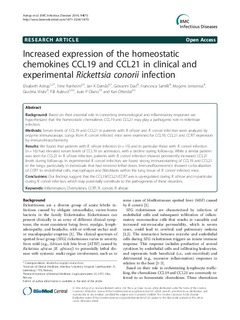| dc.contributor.author | Astrup, Elisabeth | |
| dc.contributor.author | Ranheim, Trine | |
| dc.contributor.author | Damås, Jan Kristian | |
| dc.contributor.author | Davi, Giovanni | |
| dc.contributor.author | Santilli, Francesca | |
| dc.contributor.author | Jensenius, Mogens | |
| dc.contributor.author | Vitale, Giustina | |
| dc.contributor.author | Aukrust, Pål | |
| dc.contributor.author | Olano, Juan P | |
| dc.contributor.author | Otterdal, Kari | |
| dc.date.accessioned | 2015-09-30T07:29:07Z | |
| dc.date.accessioned | 2015-10-27T14:24:39Z | |
| dc.date.available | 2015-09-30T07:29:07Z | |
| dc.date.available | 2015-10-27T14:24:39Z | |
| dc.date.issued | 2014 | |
| dc.identifier.citation | BMC Infectious Diseases 2014, 14(1) | nb_NO |
| dc.identifier.issn | 1471-2334 | |
| dc.identifier.uri | http://hdl.handle.net/11250/2358184 | |
| dc.description.abstract | Background: Based on their essential role in concerting immunological and inflammatory responses we
hypothesized that the homeostatic chemokines CCL19 and CCL21 may play a pathogenic role in rickettsiae
infection.
Methods: Serum levels of CCL19 and CCL21 in patients with R. africae and R. conorii infection were analyzed by
enzyme immunoassays. Lungs from R. conorii infected mice were examined for CCL19, CCL21 and CCR7 expression
by immunohistochemistry.
Results: We found that patients with R. africae infection (n = 15) and in particular those with R. conorii infection
(n = 16) had elevated serum levels of CCL19 on admission, with a decline during follow-up. While a similar pattern
was seen for CCL21 in R. africae infection, patients with R. conorii infection showed persistently increased CCL21
levels during follow-up. In experimental R. conorii infection, we found strong immunostaining of CCL19 and CCL21
in the lungs, particularly in individuals that had received lethal doses. Immunofluorescence showed co-localization
of CCR7 to endothelial cells, macrophages and fibroblasts within the lung tissue of R. conorii infected mice.
Conclusions: Our findings suggest that the CCL19/CCL21/CCR7 axis is up-regulated during R. africae and in particular
during R. conorii infection, which may potentially contribute to the pathogenesis of these disorders. | nb_NO |
| dc.language.iso | eng | nb_NO |
| dc.publisher | BioMed Central | nb_NO |
| dc.title | Increased expression of the homeostatic chemokines CCL19 and CCL21 in clinical and experimental Rickettsia conorii infection | nb_NO |
| dc.type | Journal article | nb_NO |
| dc.type | Peer reviewed | en_GB |
| dc.date.updated | 2015-09-30T07:29:07Z | |
| dc.source.volume | 14 | nb_NO |
| dc.source.journal | BMC Infectious Diseases | nb_NO |
| dc.source.issue | 1 | nb_NO |
| dc.identifier.doi | 10.1186/1471-2334-14-70 | |
| dc.identifier.cristin | 1172505 | |
| dc.relation.project | Norges forskningsråd: 223255 | nb_NO |
| dc.description.localcode | © 2014 Astrup et al.; licensee BioMed Central Ltd. This is an Open Access article distributed under the terms of the Creative Commons Attribution License (http://creativecommons.org/licenses/by/2.0), which permits unrestricted use, distribution, and reproduction in any medium, provided the original work is properly credited. The Creative Commons Public Domain Dedication waiver (http://creativecommons.org/publicdomain/zero/1.0/) applies to the data made available in this article, unless otherwise stated. | nb_NO |
